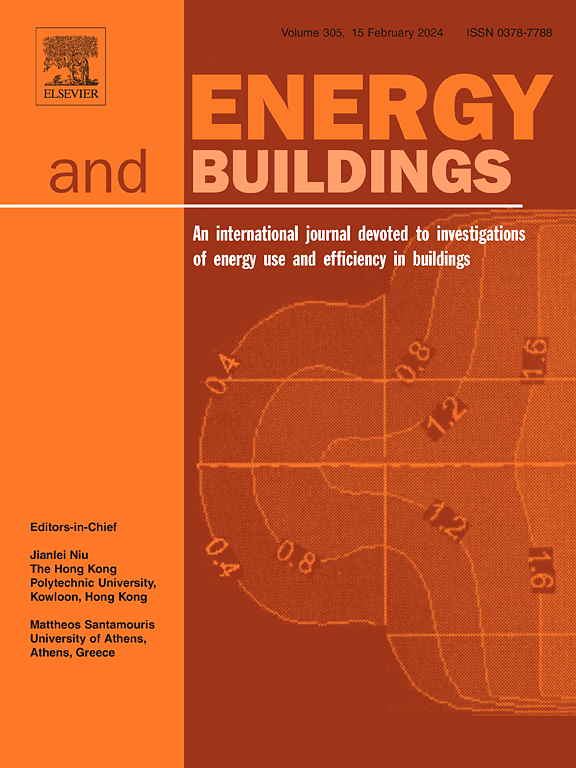推进在太阳能密集气候的冷却负荷评估:ΔT-based太阳能-空气温度方法增强自由冷却建模
IF 7.1
2区 工程技术
Q1 CONSTRUCTION & BUILDING TECHNOLOGY
引用次数: 0
摘要
本研究引入了一种新的太阳能-空气温度(Tsa)驱动框架,以增强传统的冷却度小时(CDH)方法,以准确评估高太阳辐照区域的冷却需求和自然冷却潜力。与仅依赖环境温度的标准CDH模型不同,因此低估了冷却负荷,该模型纳入了Tsa,这是一个综合了太阳辐射、天空温度、表面发射率和吸收率的复合参数,同时捕获了对流和辐射效应。利用土耳其Muğla的31年每小时气象数据,开发了一个ΔT-based天空分类算法,以动态估计不同云层条件下的天空温度。该研究系统地调查了三种室内设定温度(18°C, 22°C, 26°C)和多种发射率情景,以量化机械和自然冷却需求。结果表明,使用Tsa代替环境温度可以使夏季高峰中午计算的CDH增加高达12°C,暴露了传统模型的局限性。当设定点为26℃,发射率ε = 0.9时,机械冷却需求下降30%以上,年自由冷却小时超过61,000℃·h。即使在较低的设定值(18°C, 22°C)下,也观察到相当大的夜间和肩季自由冷却潜力。这种混合方法将经验简单性和物理现实性结合起来,为早期设计决策和政策应用提供了可扩展的低数据解决方案。通过解决一个关键的研究空白,即在简化的冷却模型中排除辐射增益,本研究提供了一种气候响应方法,以推进可持续建筑冷却策略,特别是在地中海和太阳能密集型气候中。本文章由计算机程序翻译,如有差异,请以英文原文为准。
Advancing cooling load assessment in solar-intensive climates: A ΔT-based solar-air temperature approach for enhanced free cooling modeling
This study introduces a novel solar-air temperature (Tsa)-driven framework to enhance the conventional Cooling Degree Hour (CDH) method for accurately assessing cooling demand and free cooling potential in high solar irradiance regions. Unlike standard CDH models that rely solely on ambient temperature and thus underestimate cooling loads, the proposed model incorporates Tsa, a composite parameter that integrates solar radiation, sky temperature, surface emissivity, and absorptivity, capturing both convective and radiative effects. A ΔT-based sky classification algorithm was developed using 31 years of hourly meteorological data for Muğla, Turkey, to dynamically estimate sky temperatures under varying cloud conditions. The study systematically investigates three indoor setpoint temperatures (18 °C, 22 °C, 26 °C) and multiple emissivity scenarios to quantify mechanical and free cooling demands. The results reveal that using Tsa instead of ambient temperature can increase the calculated CDH by up to 12 °C during peak summer midday, exposing the limitations of traditional models. At a setpoint of 26 °C and emissivity ε = 0.9, mechanical cooling demand drops by over 30 %, and annual free cooling hours exceed 61,000 °C·h. Even at lower setpoints (18 °C, 22 °C), considerable nighttime and shoulder-season free cooling potential was observed. This hybrid approach bridges empirical simplicity and physical realism, offering a scalable, low-data solution for early design decisions and policy applications. By addressing a key research gap, the exclusion of radiative gains in simplified cooling models, this study provides a climate-responsive methodology to advance sustainable building cooling strategies, especially in Mediterranean and solar-intensive climates.
求助全文
通过发布文献求助,成功后即可免费获取论文全文。
去求助
来源期刊

Energy and Buildings
工程技术-工程:土木
CiteScore
12.70
自引率
11.90%
发文量
863
审稿时长
38 days
期刊介绍:
An international journal devoted to investigations of energy use and efficiency in buildings
Energy and Buildings is an international journal publishing articles with explicit links to energy use in buildings. The aim is to present new research results, and new proven practice aimed at reducing the energy needs of a building and improving indoor environment quality.
 求助内容:
求助内容: 应助结果提醒方式:
应助结果提醒方式:


